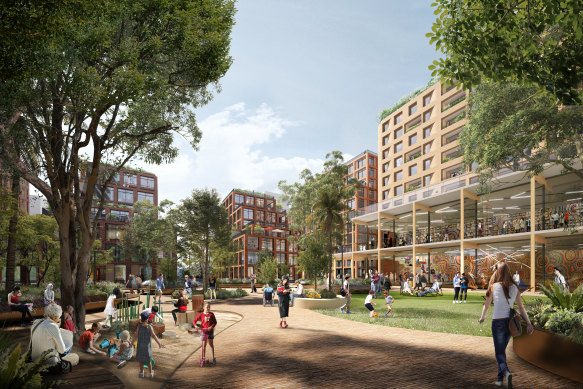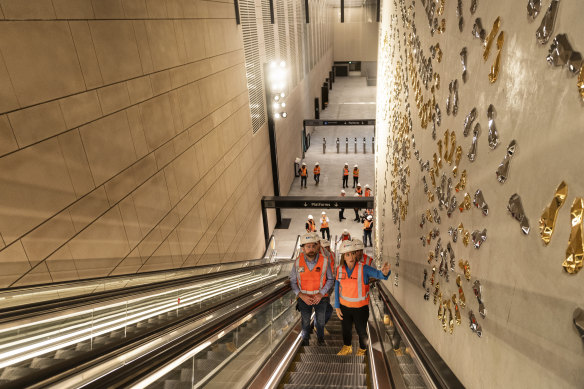This was published 10 months ago
The metro will transform this Sydney suburb but not everyone’s on board
By Megan Gorrey
It’s approaching noon as Sonny Morgan smokes a cigarette, and his mate swigs a beer, while they perch on an outdoor table in the grounds of Waterloo’s public housing estate, metres from the dazzling station which opened as part of Sydney’s new $21.6 billion metro rail line hours earlier.
“I’ve been on it already this morning,” Morgan says of the rail line.

The plans for Waterloo South include 3000 dwellings and a 2.2-hectare public park next to the future metro station.
“It cost me nearly $5 to get to Central. That’s $10 here and back. It’s good, it’s just the price is too high.”
Morgan, 50, lives in the estate’s Marton building. He is one of nearly 2500 public housing tenants whose lives were plunged into limbo when the NSW government announced in 2015 that Waterloo in the inner south had beaten Sydney University as the site for a new station on the City and Southwest metro line.
It would be the catalyst for a divisive redevelopment: the estate would be bulldozed and rebuilt with 3000 dwellings, a mix of social and affordable homes, and private units.
If the state government can pull off its game plan, the metro line will be the remaking of Waterloo.
Vulnerable residents of the 1970s estate will be shifted nearby and returned to a suburb transformed. Many have spent the past decade battling to save their homes from the wrecking ball; they have also bristled at the idea the redevelopment would help lift tenants out of disadvantage.
A Stockland-led consortium is responsible for the first stage of the revamp, Waterloo South, and for knitting together the new community of social housing residents and private apartment owners.
REDWatch community group spokesman Geoff Turnbull said: “It’s easy to think of [the station] as a Trojan horse that went in because it provided the basis for redeveloping the adjoining housing.”
“Will it change Waterloo? On one level, people will more easily be able to get into town, but it might not be places they really want to go.”

Transport Minister Jo Haylen (right) tours the new Waterloo metro station earlier this year.Credit: Rhett Wyman
For some, the transformation triggered by the metro station can’t come soon enough. Hung Tat, 63, has lived in the estate’s 30-storey Turanga building for 23 years and is disappointed any changes to the “terrible, horrible” building are possibly decades away.
The state government and the City of Sydney are still working on plans for the later stages of the redevelopment, Waterloo Central and Waterloo North, which comprise the larger housing blocks and two high-rise towers.
“The high-rise buildings have too many people. Alcohol, drugs, fighting, noise, every day. Every single day. But what can you do? I don’t want any trouble,” Tat says.
“We’ll have to wait a long time. It won’t be easy because we might have to move. I heard they’ll do the other buildings first, so it could be 10, 15, 20 years away. Who knows?”
Tat said the metro would “be a good thing” for the many elderly people who lived on the estate.
Waterloo Mixed Business owner Maher Al-Sheik has watched the construction of the station unfold over the last five years from his convenience store across the road.
“It’s been a big, big, big job,” he said on Monday. “It hasn’t really been busy yet, maybe because it’s the first day.
“But five minutes away you’ve got the college, the university, Channel Seven; I think it will be good for the area, for the shops. There used to be so much rubbish on the road, and now it’s all clean.”
Ben Sittiporm, 40, rents nearby and said the station would mean residents didn’t need to walk to Redfern, and the future mixed-use development around the station would attract more visitors.
“It’s going to help transport in the area, as well as the local people and businesses. I think it will be really helpful for the [public housing] community, I think this will benefit them as well.
“It’s going to be a good spot.”
Start the day with a summary of the day’s most important and interesting stories, analysis and insights. Sign up for our Morning Edition newsletter.